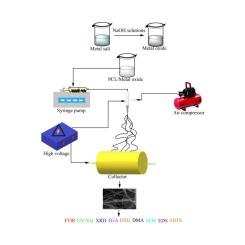Fabrication, antioxidant, and optical properties of Poly(ε-caprolactone)/metal oxide fibers by electroblowing
IF 4.6
3区 材料科学
Q2 MATERIALS SCIENCE, MULTIDISCIPLINARY
引用次数: 0
Abstract
The properties of nanofibers (NFs), such as their aspect ratio, tensile strength, porosity, and the ability to combine organic–inorganic materials, make them important in biomedical applications, electronics, and optics. Several methods for the production of these NFs are still being developed, and electroblowing is one such method. This method allows for high yields in very short times, while also saving energy through the use of airflow. By utilizing the advantages of this method, metal oxide nanoparticle ()NFs will have the potential to be used in many applications, stimulating the production of new materials. In this study, poly(ε-caprolactone)(PCL)/MeONP NFs were produced via electroblowing using PCL obtained by deposition, along with copper oxide (CuO), iron oxide (FeOx), and manganese oxide (MnO) NPs. These fibers were characterized by FTIR, UV–Vis spectroscopy, XRD, TGA, DTG, DMA, SEM, and EDS analyses. These PCL/MeONP NFs were observed to have antioxidant properties by the 2,2′-Azino-bis(3-ethylbenzothiazoline-6-sulfonic acid) (ABTS) assay, and the highest antioxidant activity of 54.32 μg TE/mg was obtained from PCL/CuO NFs. The estimated optical band gap of these nanofibers was calculated to be 2.41–2.82 eV. PCL and MeONPs are widely used as biomaterials, and the electroblown PCL/MeONP NFs presented for the first time in this study have the potential to be used as biomaterials in many biomedical applications.

聚(ε-己内酯)/金属氧化物纤维的电吹制、抗氧化及光学性能
纳米纤维(NFs)的特性,如长宽比、拉伸强度、孔隙率以及有机-无机材料结合的能力,使其在生物医学、电子和光学应用中具有重要意义。生产这些纳米颗粒的几种方法仍在开发中,电吹就是其中一种方法。这种方法可以在很短的时间内获得高产量,同时还可以通过使用气流节省能源。通过利用该方法的优点,金属氧化物纳米颗粒()NFs将具有在许多应用中使用的潜力,刺激新材料的生产。本研究利用沉积得到的PCL与氧化铜(CuO)、氧化铁(FeOx)和氧化锰(MnO) NPs,通过电吹法制备了聚ε-己内酯(PCL)/MeONP NFs。通过FTIR、UV-Vis光谱、XRD、TGA、DTG、DMA、SEM和EDS分析对纤维进行了表征。通过2,2′-氮基-双(3-乙基苯并噻唑啉-6-磺酸)(ABTS)实验观察到这些PCL/MeONP NFs具有抗氧化性能,PCL/CuO NFs的抗氧化活性最高,为54.32 μ TE/mg。计算出这些纳米纤维的光学带隙为2.41 ~ 2.82 eV。PCL和MeONP作为生物材料得到了广泛的应用,本研究首次提出的电吹PCL/MeONP NFs具有在许多生物医学应用中作为生物材料的潜力。
本文章由计算机程序翻译,如有差异,请以英文原文为准。
求助全文
约1分钟内获得全文
求助全文
来源期刊

Materials Science and Engineering: B
工程技术-材料科学:综合
CiteScore
5.60
自引率
2.80%
发文量
481
审稿时长
3.5 months
期刊介绍:
The journal provides an international medium for the publication of theoretical and experimental studies and reviews related to the electronic, electrochemical, ionic, magnetic, optical, and biosensing properties of solid state materials in bulk, thin film and particulate forms. Papers dealing with synthesis, processing, characterization, structure, physical properties and computational aspects of nano-crystalline, crystalline, amorphous and glassy forms of ceramics, semiconductors, layered insertion compounds, low-dimensional compounds and systems, fast-ion conductors, polymers and dielectrics are viewed as suitable for publication. Articles focused on nano-structured aspects of these advanced solid-state materials will also be considered suitable.
 求助内容:
求助内容: 应助结果提醒方式:
应助结果提醒方式:


